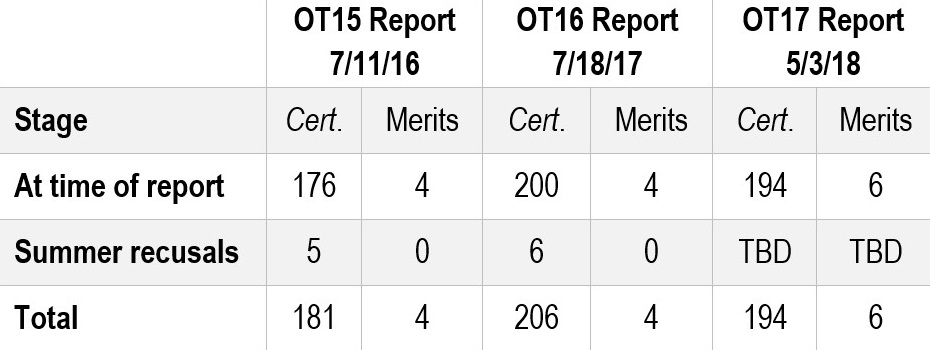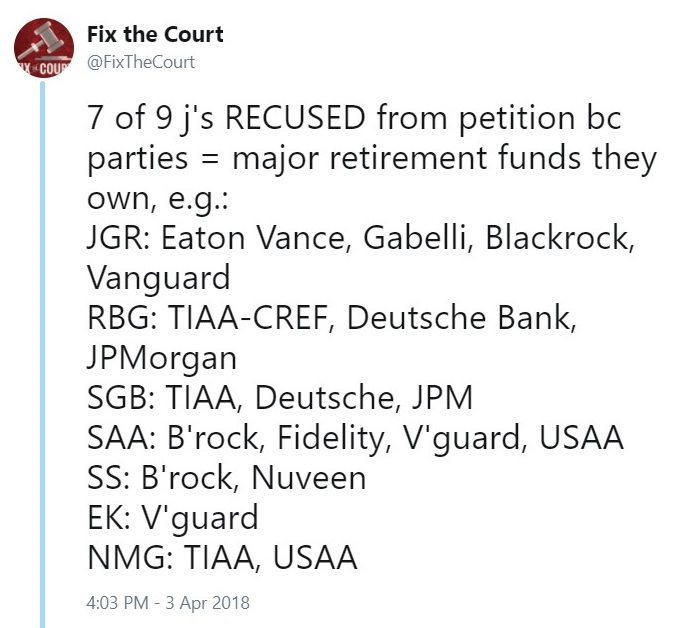Is Gorsuch Disqualified from Hearing Gitmo Cases? Plus Other Things We Learned Uncovering SCOTUS's Recusals
In our annual Recusal Report, we look for that answer and for the reasons behind the 199 other* disqualifications
(*Since this report came out, the justices have recused themselves another 13 times; see their recent orders lists.)
Documents uncovered in a Fix the Court FOIA lawsuit last year may have led to the recusal of Supreme Court Justice Neil Gorsuch this term from a Guantanamo petition, al Bahlul v. U.S., and another government detention case, according to a new report released today by the nonpartisan judiciary watchdog group. Yet two non-recusals in related cases present a less-than-clear picture.
Soon after Gorsuch, a Bush 43 Justice Department official, was nominated to the high court, the public learned of his role in supporting the extraterritorial prison and its system of justice thanks in part to the FTC suit, which helped compel the release of 144,000 pages of his e-mails to the Senate Judiciary Committee. Included in that trove were documents showing that Gorsuch visited Guantanamo and suggested that federal judges visit, as well, so they’d become more sympathetic to the administration’s policies there.
 On the same day as the Guantanamo recusal (Oct. 10, 2017), Gorsuch also disqualified himself from Geo Group v. Detention Watch Network et al., a suit in which immigrants’ rights group were looking to compel the production of contracts that ICE and the Department of Homeland Security have with private prisons. It is unclear if these two recusals are related. At the same time, Gorsuch sat on Dalmazzi v. U.S., a case argued in January concerning military commissions and dual-appointed judges, and al-Nashiri v. U.S., a petition from the U.S.S. Cole bomber, now a Guantanamo detainee, that was denied cert. on Oct. 17.
On the same day as the Guantanamo recusal (Oct. 10, 2017), Gorsuch also disqualified himself from Geo Group v. Detention Watch Network et al., a suit in which immigrants’ rights group were looking to compel the production of contracts that ICE and the Department of Homeland Security have with private prisons. It is unclear if these two recusals are related. At the same time, Gorsuch sat on Dalmazzi v. U.S., a case argued in January concerning military commissions and dual-appointed judges, and al-Nashiri v. U.S., a petition from the U.S.S. Cole bomber, now a Guantanamo detainee, that was denied cert. on Oct. 17.
“Gorsuch’s Justice Department e-mails show he worked on military commissions and related Guantanamo issues, and his recusal from a Supreme Court petition on the commissions’ legality seems to confirm he’s aware how this work could pose a conflict,” FTC executive director Gabe Roth said. “It’s unclear, though, why he’d recuse himself from one Guantanamo case and sit on two others.”
“These types of miscalculations – not to mention the late Kagan and Kennedy recusals this term – do not give the public confidence that the justices are taking their ethics obligations seriously,” Roth added.
Here is the recusal report. Here is an easy-to-read chart of the recusals. Here are the OT17 orders that include recusals.
 Among the justices’ 200 recusals so far this term, other standouts include the seven recusal order issued by Justices Kennedy and Thomas April 3 in litigation from the 2007 Tribune Co. leveraged buyout, Deutsche Bank Trust Company Americas, et al. v. Robert R. McCormick Foundation, et al. In it the two justices wrote, “[Lower courts] could decide whether relief from judgment is appropriate given the possibility that there might not be a quorum in this court.” Within minutes, FTC was able to determine the reason for the statement: every justice save Kennedy and Thomas is invested in at least one of the retirement accounts and mutual funds – like Fidelity, Vanguard and TIAA-CREF – listed among the 154 pages of creditors.
Among the justices’ 200 recusals so far this term, other standouts include the seven recusal order issued by Justices Kennedy and Thomas April 3 in litigation from the 2007 Tribune Co. leveraged buyout, Deutsche Bank Trust Company Americas, et al. v. Robert R. McCormick Foundation, et al. In it the two justices wrote, “[Lower courts] could decide whether relief from judgment is appropriate given the possibility that there might not be a quorum in this court.” Within minutes, FTC was able to determine the reason for the statement: every justice save Kennedy and Thomas is invested in at least one of the retirement accounts and mutual funds – like Fidelity, Vanguard and TIAA-CREF – listed among the 154 pages of creditors.
Despite that order, the three justices who individual stock – Roberts, Breyer and Alito – have only stepped aside from 28 petitions this term, down from 47 last term. Alito once again led with 25 of these recusals (see the report), followed by Roberts with two, both due to his Time-Warner investment, and Breyer with one, on account of his Pearson stock.
There were three petitions and one disbarment this term whose recusals FTC could not definitively figure out. In addition to the Gorsuch recusal in Geo Group v. Detention Watch Network et. al (mentioned above), the reasons for his recusals in Opalinski v. Robert Half International, a Fair Labor Standards Act case from the Third Circuit, and Foot Locker v. Osberg, an ERISA suit from the Second Circuit, could not be determined.
Why Justice Thomas disqualified himself from the Oct. 2 disbarment of Elbert Walton, Jr., is also unclear. Walton is a prominent St. Louis-based lawyer and former member of the Missouri House of Representatives (1979-1992) who then became the attorney of the local fire district and got into trouble for yelling at a judge. Thomas worked in Missouri from 1974 to 1979, first as assistant attorney general in Jefferson City and then as an attorney with Monsanto in St. Louis. It is presumed the two know each other from their time in Missouri, but FTC has yet to find proof.
Finally, this term again featured missed recusals and unrecusals at the merits stage. On Oct. 10 Justice Kagan recused herself from Jennings v. Rodriguez, even though the case had been argued in OT16 to a 4-4 tie and reargued in OT17, with Kagan participating both times. Justice Kennedy on Mar. 23 recused himself from a decades-old case involving Native American fishing rights, Washington v. U.S., argued Apr. 18, because he had sat on an earlier version of the suit in 1985 while serving as a Ninth Circuit judge. (We’ll give Kennedy a pass on that one.) After recusing himself from the Jan. 12 cert. grant in WesternGeco (a Schlumberger subsidiary) v. ION Geophysical, Justice Alito sold his Schlumberger shares, worth up to $15,000, and on Mar. 28 noted that he was no longer recused.
All in all, the six merits-stage recusals in OT17 were Kagan in Rubin v. Islamic Republic of Iran and Jennings v. Rodriguez, Kennedy in Washington v. U.S. and Gorsuch in City of Hays v. Vogt, Dahda v. U.S. and Chavez-Mesa v. U.S.
The first two were decided in February, and the latter four will be decided by the end of June, with a 4-4 tie being a possibility in each.